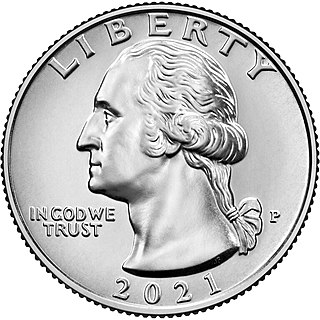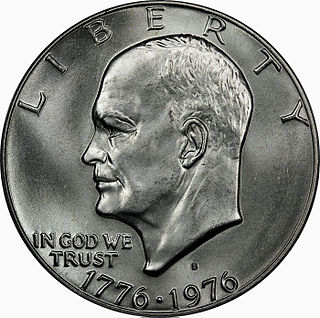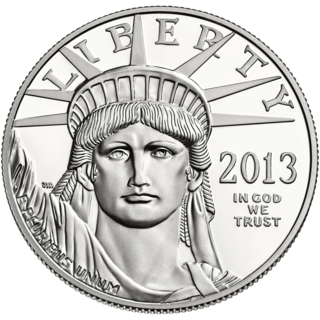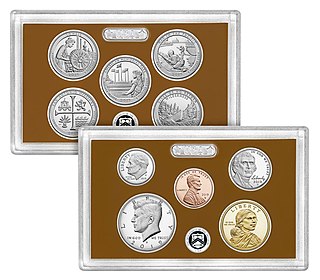
The quarter, short for quarter dollar, is a United States coin worth 25 cents, one-quarter of a dollar. The coin sports the profile of George Washington on its obverse, and after 1998 its reverse design has changed frequently. It has been produced on and off since 1796 and consistently since 1831.
Coins of the United States dollar were first minted in 1792. New coins have been produced annually and they make up a valuable aspect of the United States currency system. Today, circulating coins exist in denominations of 1¢, 5¢, 10¢, 25¢, 50¢, and $1.00. Also minted are bullion and commemorative coins. All of these are produced by the United States Mint. The coins are then sold to Federal Reserve Banks which in turn are responsible for putting coins into circulation and withdrawing them as demanded by the country's economy.
The dollar coin is a United States coin with a face value of one United States dollar. Dollar coins have been minted in the United States in gold, silver, and base metal versions. Dollar coins were first minted in the United States in 1794.

The United States Bicentennial coinage is a set of circulating commemorative coins, consisting of a quarter, half dollar and dollar struck by the United States Mint in 1975 and 1976. Regardless of when struck, each coin bears the double date 1776–1976 on the normal obverses for the Washington quarter, Kennedy half dollar and Eisenhower dollar. No coins dated 1975 of any of the three denominations were minted.

The American Silver Eagle is the official silver bullion coin of the United States.

The American Gold Eagle is an official gold bullion coin of the United States. Authorized under the Gold Bullion Coin Act of 1985, it was first released by the United States Mint in 1986. Because the term "eagle" also is the official United States designation for pre-1933 ten dollars gold coins, the weight of the bullion coin is typically used when describing American Gold Eagles to avoid confusion. This is particularly true with the 1/4-oz American Gold Eagle, which has a marked face value of ten dollars.

The American Platinum Eagle is the official platinum bullion coin of the United States. In 1995, Director of the United States Mint Philip N. Diehl, American Numismatic Association President David L. Ganz, and Platinum Guild International Executive Director Jacques Luben began the legislative process of creating the Platinum Eagle. After over two years of work, the 99.95% fine platinum coins were released by the United States Mint in 1⁄10, 1⁄4, 1⁄2 and 1 troy oz denominations. In late 2008, the fractional denominations were discontinued, leaving only the one ounce denomination. The Platinum Eagle is authorized by the United States Congress, and is backed by the United States Mint for weight, content, and purity.

The Eisenhower Commemorative silver dollar is a United States commemorative coin minted in 1990 to celebrate the 100th Anniversary of the birth of General/President Dwight D. Eisenhower. This coin is not to be confused with the Eisenhower dollar or the Eisenhower Presidential dollar which were regular issue American coins.

The San Francisco Mint is a branch of the United States Mint. Opened in 1854 to serve the gold mines of the California Gold Rush, in twenty years its operations exceeded the capacity of the first building. It moved into a new one in 1874, now known as the Old San Francisco Mint. In 1937 Mint operations moved into a third building, the current one, completed that year.

The West Point Mint is a U.S. Mint production and depository facility erected in 1937 near the U.S. Military Academy in West Point, New York, United States. As of 2019 the mint holds 22% of the United States' gold reserves, or approximately 54 million ounces. The mint at West Point is second only to the gold reserves held in secure storage at Fort Knox. Originally, the West Point Mint was called the West Point Bullion Depository. At one point it had the highest concentration of silver of any U.S. mint facility, and for 12 years produced circulating Lincoln cents. It has since minted mostly commemorative coins and stored gold.

The Manx Noble are platinum, gold or silver bullion coins distributed by the Isle of Man and minted by private companies. While platinum coins have been minted since the early 1800s, the Noble is the first platinum coin created for investors. The coins are not minted every year, but have an erratic schedule. Nobles are legal tender but they do not have a fixed face value; instead, like the Krugerrand or Mexico's Libertad, they are legal tender to the value of their precious metal content.

The American Buffalo, also known as a gold buffalo, is a 24-karat bullion coin first offered for sale by the United States Mint on June 22, 2006, and available for shipment beginning on July 13. The coin follows the design of the Indian Head nickel and has gained its nickname from the American Bison on the reverse side of the design. This was the first time ever that the United States Government has minted pure (.9999) 24-karat gold coins for the public. The coin has a legal tender (face) value of US$50. Due to a combination of the coin's popularity and the tremendous increase in the price of gold since its creation the coin's value has increased considerably in a short time of just a few years. The initial 2006 U.S. Mint price of the proof coin was $800. In 2007 the Mint proof coin was $899.95, $1,410.00 in 2009, and $2,010.00 in 2011.

In 2007, the United States Mint released a gold five-dollar commemorative coin which commemorates the 400th year after the founding of Jamestown. Surcharges from the sale of the Jamestown commemorative were donated to Jamestown-Yorktown Foundation of the Commonwealth of Virginia, the Secretary of the Interior and the Association for the Preservation of Virginia Antiquities to support programs that promote the understanding of the legacies of Jamestown.
The America the Beautiful quarters were a series of 56 25-cent pieces (quarters) issued by the United States Mint, which began in 2010 and lasted until 2021. The obverse (front) of all the coins depicts George Washington in a modified version of the portrait used for the original 1932 Washington quarter. There were five new reverse (back) designs each year, each commemorating a national natural or historic site such as national parks, national historic site, or national forests – one from each state, the federal district, and each territory. The program was authorized by the America's Beautiful National Parks Quarter Dollar Coin Act of 2008 (Pub.L. 110–456 .

The American Palladium Eagle is the official palladium bullion coin of the United States. Each coin has a face value of $25 and contains 99.95% fine palladium. It was authorized by the American Eagle Palladium Bullion Coin Act of 2010 which became Public Law 111-303 passed during the 111th United States Congress. The Palladium Eagle uses Adolph Weinman's obverse design on the Mercury dime, Liberty wearing a winged hat, while its reverse design is based on Weinman's 1907 American Institute of Architects (AIA) medal design.

The George Washington 250th Anniversary half dollar is a commemorative coin that was issued by the United States Mint to commemorate the 250th anniversary of the birth of George Washington. The coin was authorized by Pub.L. 97–104.

The Apollo 11 50th Anniversary commemorative coins were issued by the United States Mint in 2019 to commemorate the 50th anniversary of the first crewed landing on the Moon by Apollo 11 astronauts Neil Armstrong and Buzz Aldrin. Consisting of a gold half eagle, two different sizes of silver dollars, and a copper-nickel clad half dollar, each of the four was issued in proof condition, with all but the larger silver dollar also issued in uncirculated. The gold coins were struck at the West Point Mint, the silver at the Philadelphia Mint and the base metal half dollars at the mints in Denver and San Francisco.

The United States Mint Proof Set, commonly known as the Proof Set in the United States, is a set of proof coins sold by the United States Mint. The proof set is popular with coin collectors as it is an affordable way to collect examples of United States coinage in proof condition.

The Korean War Memorial silver dollar is a commemorative silver dollar issued by the United States Mint in 1991. The coin commemorated the 38th anniversary of the end of the Korean War.

Library of Congress silver dollar is a commemorative coin issued by the United States Mint in 2000. The coin was part of a two-coin series authorized by Pub.L. 105–268 (text)(PDF) commemorating the 200th anniversary of the Library of Congress.


















